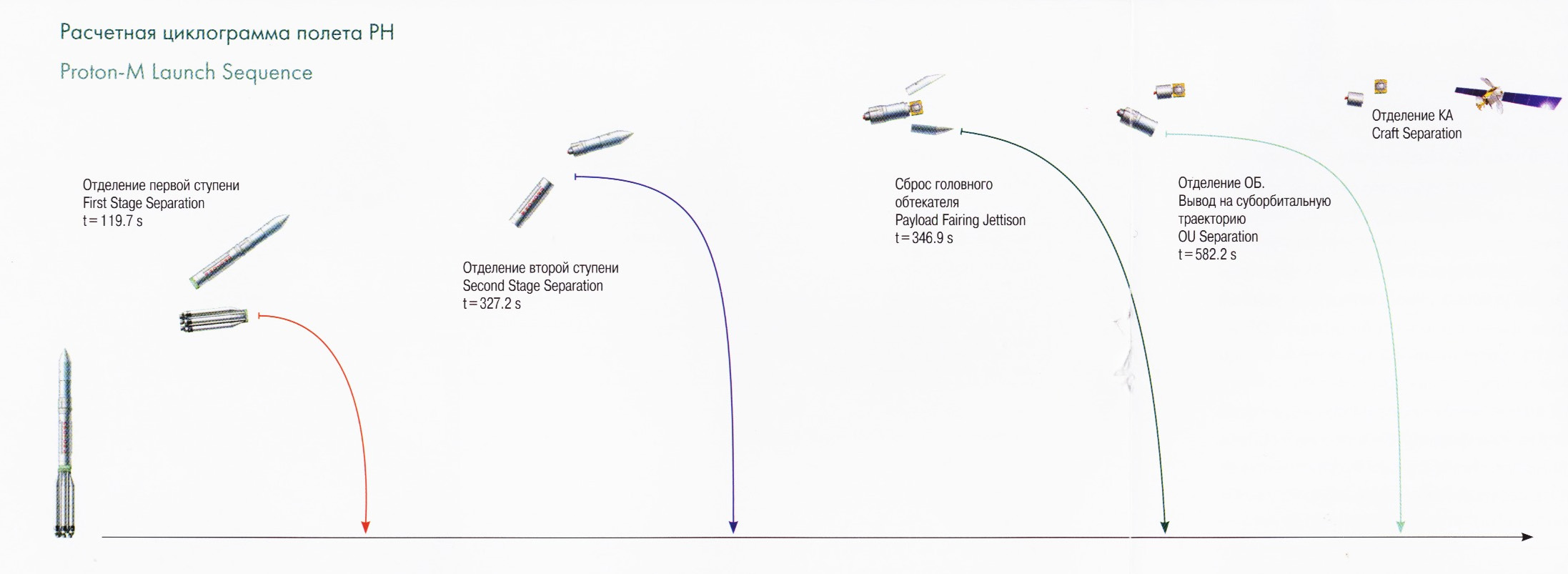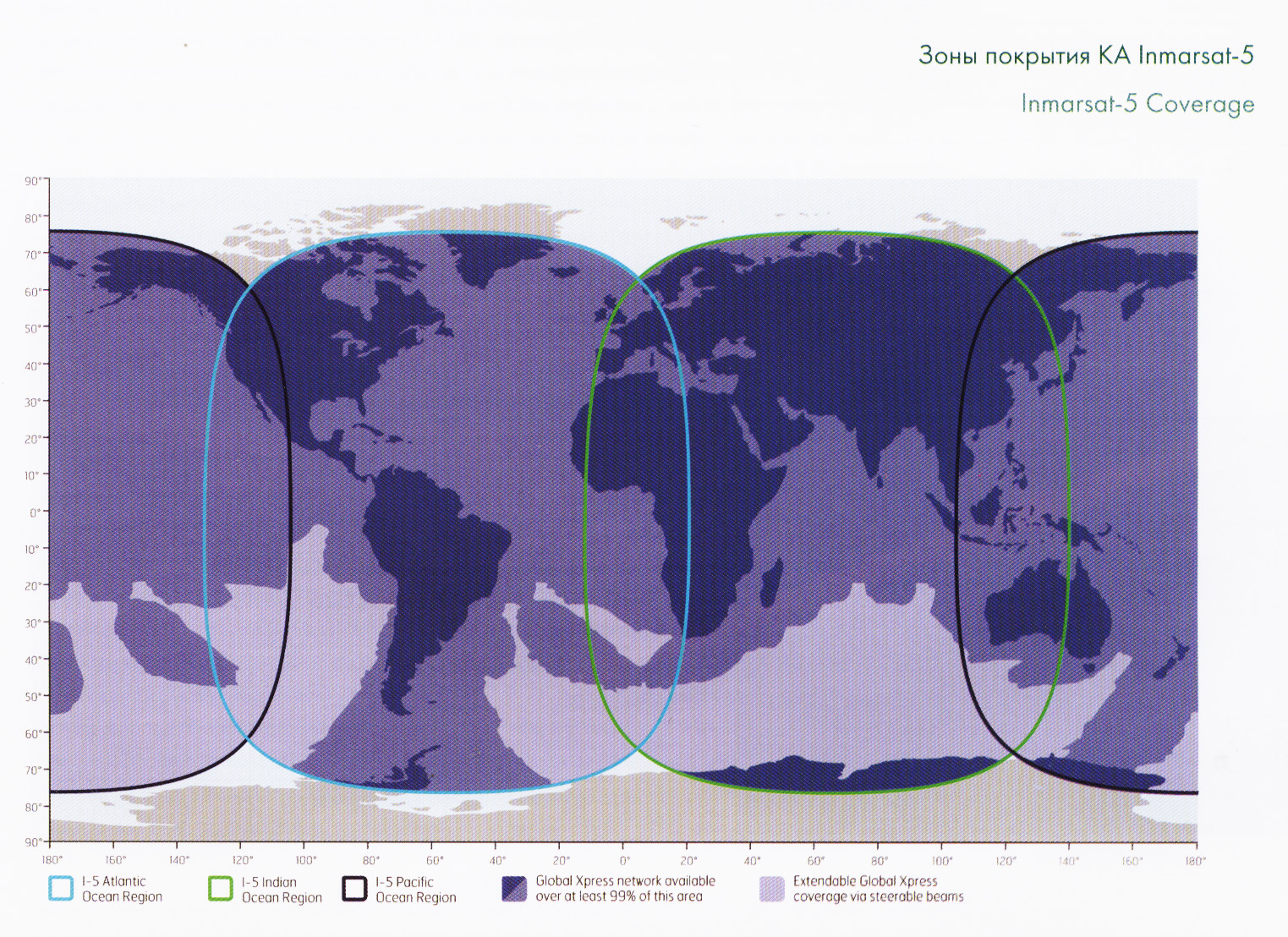To paraphrase an ad from a certain worldwide bank.....the Proton never sleeps. Oh yes, here comes another Proton launch! The 7th Proton launch of the year for ILS will carry the first of a series of large mobile communication satellites for the London based Inmarsat, one of the earliest satellite communication companies that started out (and still is) providing satellite telecom to ships around the world. With a huge number of 89 spot beams on each satellite, the Inmarsat 5 series will provide broadband Internet et al. services around the globe.
This is the 7th commercial mission of the year for ILS and the 84th ILS Proton mission since the first commercial flight of the Proton in April 1996.
This is the 3rd Inmarsat satellite launched with Proton and the 16th Boeing-built satellite launched on Proton.





Launch location:
Baikonur Launch pad no. 200/39 46° 2'23.85"N, 63° 1'54.98"E

Launch dates and times:
{colsp=6}Launch times
Time Zone |
{colsp=6}
Live Coverage Of The Launch:
PAYLOAD
Inmarsat 5-F1 communication satellite:

Mission Summary
Inmarsat ordered three Ka-band Inmarsat-5 satellites in August 2010 from Boeing for about $1 billion to deliver faster broadband to its commercial and government customers by end-2014.
The fixed-price contract, with options, calls for three BSS-702HP commercial spacecraft that will operate in geosynchronous orbit with flexible global coverage.
Each Inmarsat-5 satellite will carry 89 Ka-band beams that will operate in geosynchronous orbit with flexible global coverage. The satellites are designed to generate approximately 15 kilowatts of power at the start of service and approximately 13.8 kilowatts at the end of their 15-year design life. To generate such high power, each spacecraft's two solar wings employ five panels each of ultra triple-junction gallium arsenide solar cells. The BSS-702HP carries the xenon ion propulsion system (XIPS) for all on-orbit maneuvering. When operational, the Inmarsat-5 satellites will provide Inmarsat with a comprehensive range of global mobile satellite services, including mobile broadband communications for deep-sea vessels, in-flight connectivity for airline passengers and streaming high-resolution video, voice and data.
The Boeing satellites will provide Inmarsat with the ability to adapt to shifting subscriber usage patterns of high data rates, specialized applications and evolving demographics over a projected 15-year lifetime. In a separate arrangement, Boeing has also entered into a distribution partnership with Inmarsat to provide L- and Ka-band capacity to key users within the U.S. government.
The Inmarsat-5 spacecraft are compatible with the Ariane, Sea Launch, Proton and Atlas launch vehicles. Launch services were procured by Inmarsat.
In October 2013, Inmarsat ordered a fourth satellite as a spare.
{colsp=2}Summary
Parameter | Value
Characteristics|
|

Launch Vehicle:
{colsp=2}Characteristics
 |
|
{colsp=2}

The vehicle's reliability statistics according to http://www.spacelaunchreport.com/log2013.html#rate:
Inmarsat 5-F1 Ascent Profile
The Proton-M first three stages place the orbital unit (OU), which consists of a Breeze-M upper stage, adapter system and Inmarsat 5-F1, into a 51.5° inclination suborbital trajectory.
Proton-M powered flight lasts 582 seconds. The OU powered flight begins at the moment of the third stage separation.

Immediately after the separation of the third stage booster, the Breeze-M stability engines start, damping the angular velocities of the third stage separation and then providing orbital unit orientation and stability during coast flight along a suborbital trajectory to await the first burn. The upper stage follows a five-burn injection profile.



Inmarsat 5-F1 Ascent Timeline
Event|Time rel lift-off|Time UTC|Comment
Ignition Start Sequence|-00:00:02.5|12:11:57.5|
Stage 1 Ignition (40% thrust)|-00:00:01.75|12:11:58.25|
Command Stage 1 (100% thrust)|-00:00:00.9|12:11:59.1|
Maximum Dynamic Pressure|00:01:02|12:13:02|
1st/2nd Stage Separation|00:02:00|12:14:00|
2nd/3rd Stage Separation|00:05:27|12:17:27|
Payload Fairing Separation|00:05:47|12:17:47|
3rd Stage/Breeze M Separation|00:09:42|12:21:42|
1st Burn Ignition|00:11:16|12:23:16|
1st Burn Shutdown|00:15:43|12:27:43|1st Burn's Duration 00:04:27
2nd Burn Ignition|01:50:30|14:02:30|
2nd Burn Shutdown|02:10:04|14:22:04|2nd Burn's Duration 00:19:34
3rd Burn Ignition|04:23:49|16:35:49|
3rd Burn Shutdown|04:33:13|16:45:13|3rd Burn's Duration 00:09:24
APT Jettison|04:34:03|16:46:03|
4th Burn Ignition|04:35:30|16:47:30|
4th Burn Shutdown|04:43:57|16:55:57|4th Burn's Duration 00:08:27
5th Burn Ignition|15:15:05|03:27:05|
5th Burn Shutdown|15:18:34|03:30:34|5th Burn's Duration 00:03:29
Spacecraft Separation|15:31:00|03:43:00|
Weather forecast for Baikonur, Kazakhstan on December 8, 2013 (6 p.m.)
Partly cloudy skies in the morning will give way to cloudy skies during the afternoon. High near 2C. Winds ESE at 10 to 15 kmh.
Time|Temps|Dew Point|Relative Humidity|Precip|Snow|Cloud cover|Pressure|Wind|Weather
7 PM|-1°C|-6°C|70%|0%|0%|85%|1018 hPa|16 km/h ESE|
 Overcast
Overcast
References
http://www.federalspace.ru
http://tvroscosmos.ru
http://www.khrunichev.ru
http://www.ilslaunch.com
http://tihiy.fromru.com/Rn/RN_Proton.htm
http://space.skyrocket.de/doc_sdat/inmarsat-5.htm
http://www.inmarsat.com
http://www.tsenki.com
http://forum.nasaspaceflight.com
http://www.novosti-kosmonavtiki.ru
http://www.spacelaunchreport.com
http://english.wunderground.com/q/locid:KZXX0055
This is the 7th commercial mission of the year for ILS and the 84th ILS Proton mission since the first commercial flight of the Proton in April 1996.
This is the 3rd Inmarsat satellite launched with Proton and the 16th Boeing-built satellite launched on Proton.




Launch location:
Baikonur Launch pad no. 200/39 46° 2'23.85"N, 63° 1'54.98"E

Launch dates and times:
Time Zone |
Baikonur / UTC+6
|
Moscow / UTC+4
|
Universal / UTC
|
Washington / EST
|
Los Angeles / PST
Launch time (Primary):
|
18:12:00
|
16:12:00
|
12:12:00
|
07:12:00
|
04:12:00
on:
|
Dec. 8, 2013
|
Dec. 8, 2013
|
Dec. 8, 2013
|
Dec. 8, 2013
|
Dec. 8, 2013
{colsp=6}
[highlight][eventTimer]2013-12-08 12:12:00?before|after;%dd% Days %hh% Hours %mm% Minutes %ss% Seconds %c%[/eventTimer] Inmarsat 5-F1 Launch[/highlight]
Live Coverage Of The Launch:
- International Launch Services: http://inmarsat5f1.imgondemand.com/ (begins at 20 minutes before lift-off)
- TSENKI Video Streams: http://www.tv-tsenki.com/livechoose.php
- Khrunichev COOPI (login: ? password: ?): http://coopi.khrunichev.ru/main.php?id=200
- Owners of PDA can watch the launch in test mode on: http://www.space-center.ru
PAYLOAD
Inmarsat 5-F1 communication satellite:

Mission Summary
Inmarsat ordered three Ka-band Inmarsat-5 satellites in August 2010 from Boeing for about $1 billion to deliver faster broadband to its commercial and government customers by end-2014.
The fixed-price contract, with options, calls for three BSS-702HP commercial spacecraft that will operate in geosynchronous orbit with flexible global coverage.
Each Inmarsat-5 satellite will carry 89 Ka-band beams that will operate in geosynchronous orbit with flexible global coverage. The satellites are designed to generate approximately 15 kilowatts of power at the start of service and approximately 13.8 kilowatts at the end of their 15-year design life. To generate such high power, each spacecraft's two solar wings employ five panels each of ultra triple-junction gallium arsenide solar cells. The BSS-702HP carries the xenon ion propulsion system (XIPS) for all on-orbit maneuvering. When operational, the Inmarsat-5 satellites will provide Inmarsat with a comprehensive range of global mobile satellite services, including mobile broadband communications for deep-sea vessels, in-flight connectivity for airline passengers and streaming high-resolution video, voice and data.
The Boeing satellites will provide Inmarsat with the ability to adapt to shifting subscriber usage patterns of high data rates, specialized applications and evolving demographics over a projected 15-year lifetime. In a separate arrangement, Boeing has also entered into a distribution partnership with Inmarsat to provide L- and Ka-band capacity to key users within the U.S. government.
The Inmarsat-5 spacecraft are compatible with the Ariane, Sea Launch, Proton and Atlas launch vehicles. Launch services were procured by Inmarsat.
In October 2013, Inmarsat ordered a fourth satellite as a spare.
Parameter | Value
Working Orbit:
|
GEO
Orbital Location:
|
63.0° East
Coverage:
|
Europe, Asia, Africa
ApA at separation:
|
65000 km
PeA at separation:
|
4341 km
Inc at separation:
|
26.75°Inmarsat 5-F1
Customer:
|- Inmarsat
Prime contractor:
|- Boeing
Platform:
|- BSS-702HP
Mass at Separation:
|- 6070 kg
Dry Mass:
|- 3750 kg
Stabilization:
|- 3 axis stabilized
Dimensions (stowed):
|- 6.98 * 3.12 * 3.67 m
Batteries:
|- Two solar array wings each with five panels of gallium arsenide solar cells, providing 13.8 kW at end of life
Payload:
|- 89 Ka-band transponders
Life time:
|- 15 years
Coverage:
||

Launch Vehicle:

Proton-M / Briz-M
Prime contractor:
|- Khrunichev Space Centre

GRAU Index:
|- 8K82KM
Height:
| 58.2 m with upper stage and payload fairingDiameter:
| max 7.4 mLiftoff mass:
| 705 metric tonnesPayload mass:
| ~22 tonnes at LEO1st stage:
|- 6 X RD-275 engines
- Empty 30.6 tonnes
- Propellants 419.41 tonnes (UDMH and NTO)
- Thrust in vacuum 1069.8 tonnes of force
- Thrust at sea level 971.4 tonnes of force
2nd stage:
|- 1 X RD-0211 engine 3 X RD-0210 engines
- Empty 11.4 tonnes
- Propellants 156.113 tonnes (UDMH and NTO)
- Thrust in vacuum 237.4 tonnes of force
3rd stage:
|- 1 X RD-0213 engine & 1 X RD-0214 vernier engine
- Empty 3.7 tonnes
- Propellants 46.562 tonnes (UDMH and NTO)
- Thrust in vacuum 59.36 (core) + 3.15 (vernier) tonnes of force
Upper Stage:
|

- GRAU Index: 14S43
- Common Name: Briz-M
- Designer & Manufacturer: Khrunichev Space Centre
- Dimensions: Length 2.654 m, Diameter 4 m
- Empty Mass 2.2 tonnes
- Propellants 6 660 kg UDMH + 13 260 kg N2O4
- Flight time: no less than 24 hours
- Main Engine: 1 X 14D30
- Thrust in vacuum 2.0 tonnes of force
- ISP 328.6 s
- Main engine restarts: up to 8 times
- Precision Manoeuvering Engines: 4 X 11D458
- Thrust in vacuum 400 N each
- ISP 252 s
- RCS Engines: 12 X 17D58E
- Thrust in vacuum 13.3 N each
- ISP 274 s
Payload Fairing:
|- Diameter 4.35 m
- Length 11.6 m
The vehicle's reliability statistics according to http://www.spacelaunchreport.com/log2013.html#rate:
Code:
================================================================
Vehicle Successes/Tries Realzd Pred Consc. Last Dates
Rate Rate* Succes Fail
================================================================
Proton-M/Briz-M 63 69 .91 .90 7 12/08/12 2001-Inmarsat 5-F1 Ascent Profile
The Proton-M first three stages place the orbital unit (OU), which consists of a Breeze-M upper stage, adapter system and Inmarsat 5-F1, into a 51.5° inclination suborbital trajectory.
Proton-M powered flight lasts 582 seconds. The OU powered flight begins at the moment of the third stage separation.

Immediately after the separation of the third stage booster, the Breeze-M stability engines start, damping the angular velocities of the third stage separation and then providing orbital unit orientation and stability during coast flight along a suborbital trajectory to await the first burn. The upper stage follows a five-burn injection profile.



Inmarsat 5-F1 Ascent Timeline
Ignition Start Sequence|-00:00:02.5|12:11:57.5|
Stage 1 Ignition (40% thrust)|-00:00:01.75|12:11:58.25|
Command Stage 1 (100% thrust)|-00:00:00.9|12:11:59.1|
Maximum Dynamic Pressure|00:01:02|12:13:02|
1st/2nd Stage Separation|00:02:00|12:14:00|
2nd/3rd Stage Separation|00:05:27|12:17:27|
Payload Fairing Separation|00:05:47|12:17:47|
3rd Stage/Breeze M Separation|00:09:42|12:21:42|
1st Burn Ignition|00:11:16|12:23:16|
1st Burn Shutdown|00:15:43|12:27:43|1st Burn's Duration 00:04:27
2nd Burn Ignition|01:50:30|14:02:30|
2nd Burn Shutdown|02:10:04|14:22:04|2nd Burn's Duration 00:19:34
3rd Burn Ignition|04:23:49|16:35:49|
3rd Burn Shutdown|04:33:13|16:45:13|3rd Burn's Duration 00:09:24
APT Jettison|04:34:03|16:46:03|
4th Burn Ignition|04:35:30|16:47:30|
4th Burn Shutdown|04:43:57|16:55:57|4th Burn's Duration 00:08:27
5th Burn Ignition|15:15:05|03:27:05|
5th Burn Shutdown|15:18:34|03:30:34|5th Burn's Duration 00:03:29
Spacecraft Separation|15:31:00|03:43:00|
Weather forecast for Baikonur, Kazakhstan on December 8, 2013 (6 p.m.)
Partly cloudy skies in the morning will give way to cloudy skies during the afternoon. High near 2C. Winds ESE at 10 to 15 kmh.
7 PM|-1°C|-6°C|70%|0%|0%|85%|1018 hPa|16 km/h ESE|
References
http://www.federalspace.ru
http://tvroscosmos.ru
http://www.khrunichev.ru
http://www.ilslaunch.com
http://tihiy.fromru.com/Rn/RN_Proton.htm
http://space.skyrocket.de/doc_sdat/inmarsat-5.htm
http://www.inmarsat.com
http://www.tsenki.com
http://forum.nasaspaceflight.com
http://www.novosti-kosmonavtiki.ru
http://www.spacelaunchreport.com
http://english.wunderground.com/q/locid:KZXX0055
Last edited:




























